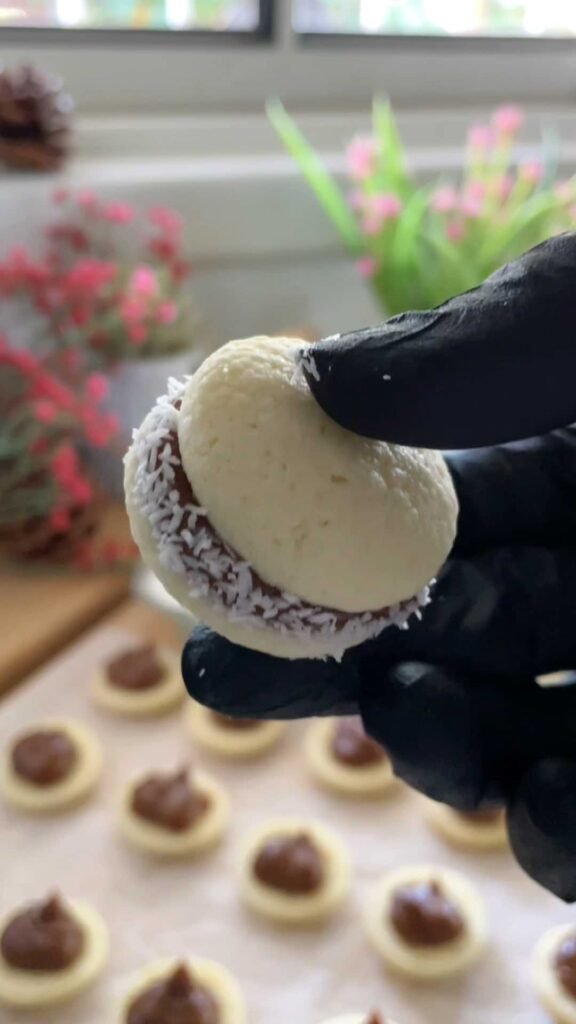Perfect Alfajores
I don’t tend to use superlatives. Each and every one of my recipes is going through a very strict QA test, yet I stay fully aware that “delicious” and “perfect” are 100% subjective descriptions. However, when my extremely picky sister tells me she just simply cannot eat any other alfajores- it takes a whole different angle for me, which means they are the perfect alfajores. Since then, many other people, whom I don’t even know have tasted these. Among them are people who don’t love alfajores at all, and the compliments never stopped. That’s when I’ve decided to publish the recipe.
A lot of alfajores recipes are calling for at least 3 egg yolks in the dough. And I also gave it a try when I had my first tried making them at home. But it felt awfully wasteful, and the result didn’t quite feel worthwhile. So, I’ve decided to develop a recipe for the perfect alfajores.
I always make a full batch because the cookies are devoured so quickly, on the same day. One of the secrets to successful alfajores is the dulce de leche filling. I use a local brand that is a mix between a stable consistency and a very good taste. Follow the instructions below and I’m sure you can succeed as well.
07-Sep-2025: Post updated to include Vegan options.
First published:
Last modified:
Perfect Alfajores:
Equipment: Round cookie cutter, 3cm (d).
Recipe: 76 Sandwiched cookies.
Cookie Dough:
| Ingredient | Amount (g / units) |
| Softened Unsalted Butter, or Vegan Butter (for Vegan version) | 225g |
| Salt | 1/8 tsp |
| Powdered Sugar | 115g |
| All Purpose Flour | 114g |
| Cornstarch | 240g |
| Baking Powder | 10g (2 tsps) |
| Eggs | 56g (1 Large sized egg), or; 46g Soy Milk (for Vegan version) |
| Vanilla Extract | 1 tsp |
Filling and Decoration:
| Ingredient | Amount (g / units) |
| Delce de Leche (A brand that is not very liquid in consistency) | 500g |
| Ground coconut | QS |
Preparation instructions:
- In a very small cup, whisk the egg together with the vanilla until uniform, and set it to the side.
- Into a medium sized bowl, sift the flour, cornstarch and baking powder. Whisk them together and set to the side.
- Into the bowl of a standing mixer fitted with the paddle attachment, add the butter, powdered sugar and salt. Cream the ingredients on medium speed for about 3 minutes, until the mixture is fluffy and creamy. Make sure to occasionally scrape the bottom of the bowl to ensure even mixing.
- Add in the dry ingredients, and mix on the lowest speed for about 30 seconds.
- Add in the egg mixture. Mix on low speed for 30 seconds. Then increase the mixing speed to medium-high, and mix for additional 15 seconds. The dough should be coming together and will become uniform.
- If your room temperature is warm, the dough may be very pasty, and not very nice to work with. Transfer it to a clean bowl and refrigerate for 1 hour. However, during winter when the kitchen is quite cold, the dough should be perfect to work with right away.
- Preheat your oven to 175C (fan mode on), with a baking rack place at the middle shelf inside the oven.
- Divide the dough roughly into thirds, and work on each part separately for convenience: roll each dough between a piece of parchment paper and a large piece of plastic wrap, to 0.5cm thickness.
- Cut out small dough circles using a round 3cm cookie cutter. It may sound small, but the cookies will puff and slightly expand during baking and will make the perfect bite size.
- Evenly space the cookies on a baking sheet lined with parchment paper.
- Bake for 6 minutes. The cookies should not brown at all (watch your oven), but they will still be fully baked. Transfer the baking sheet to a cooling rack and allow the cookies to cool down completely before filling.
- Adjust the consistency of your dulce de leche by microwaving it for a few seconds if it’s too stiff, or refrigerating it for a few minutes if it’s too loose. Transfer it to a piping bag (most convenient method to fill the cookies).
- Fill the shells with a generous amount of filling and press it with another cookie so that the filling extends all the way to the edge.
- Roll the filled cookie, sideways, in the ground coconut, for garnish.


